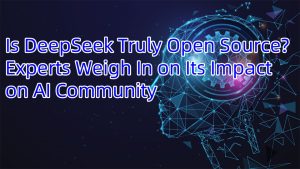DeepSeek’s open-weight AI model has sparked debate: Is it truly “open source,” or just an “open model”? Industry experts agree—its release is a game-changer for AI research and development.

Recently, a trending question on a popular Q&A platform asked: “How to evaluate DeepSeek’s claim of being open source when it seems more like an ‘Open Model’?”
To clarify, DeepSeek has not released its full training data or every technical detail, but it has open-sourced model weights, architecture, and key training methodologies—enough for researchers and developers to replicate and build upon its work.
So, is DeepSeek’s approach true open source or just a strategic partial release? And how does it impact the AI ecosystem?
1. What Has DeepSeek Actually Open-Sourced?
DeepSeek follows a “partial open-source” model, similar to Meta’s LLaMA or Mistral’s releases. Here’s what’s available:
✅ Model Weights & Architecture
-
Full model parameters (e.g., DeepSeek-R1) on Hugging Face.
-
Apache 2.0 license, allowing commercial use and modifications.
✅ Training Methodology
-
Technical reports detailing GPRO training algorithms, reinforcement learning fine-tuning, and Mixture-of-Experts (MoE) optimizations.
-
Insights into data preprocessing and Chain-of-Thought (CoT) reasoning enhancements.
❌ What’s Not Open-Sourced?
-
Raw training datasets (common due to legal/copyright concerns).
-
Full hyperparameter tuning logs.
-
Proprietary infrastructure optimizations.
Verdict: *Not “fully” open-source by strict FSF standards, but more open than most commercial AI models (e.g., OpenAI’s GPT-4).*
2. Why Experts Call It a “Major Leap Forward”
① Democratizing AI Research
-
“We haven’t eaten the pork, but at least we’ve seen the pig run,” jokes Prof. Linqi Song (City University of Hong Kong).
-
Previously, only tech giants like Google and OpenAI could afford large-scale training. Now, universities and startups can fine-tune DeepSeek’s models affordably.
② Lowering GPU Dependency
-
DeepSeek’s efficient training techniques (e.g., MoE, quantization, and distillation) reduce computing costs.
-
Prof. Meng Li (Peking University, ex-Meta AI researcher) confirms:
“Two academic teams have already replicated DeepSeek’s model—something impossible with closed models like OpenAI’s.”
③ Boosting AI Applications
-
Prof. Kejun Huang (University of Hong Kong) uses DeepSeek for AI agents and reasoning tasks, praising its cost-performance ratio.
-
Startups leverage it for AI-for-Science (protein folding, materials simulation) without expensive API calls.
3. How Does It Compare to Other “Open” Models?
| Model | Open Weights? | Open Training Data? | Full Code Release? | Commercial Use? |
|---|---|---|---|---|
| DeepSeek-R1 | ✅ Yes | ❌ No | Partial | ✅ Yes (Apache 2.0) |
| LLaMA-2 (Meta) | ✅ Yes | ❌ No | Partial | ✅ Yes (Meta license) |
| Mistral 7B | ✅ Yes | ❌ No | Partial | ✅ Yes (Apache 2.0) |
| GPT-4 (OpenAI) | ❌ No | ❌ No | ❌ No | ❌ API-only |
Conclusion: DeepSeek is as open as LLaMA and Mistral, but not as transparent as fully open-source projects like Pythia or Bloom.
4. What’s Next for Open-Source AI?
-
More academic collaborations – Universities can now experiment with cutting-edge models.
-
Cheaper AI deployments – Startups avoid costly proprietary APIs.
-
Faster innovation – Open benchmarking leads to better safety, efficiency, and reasoning improvements.
As the Financial Times noted:
“DeepSeek continues the tradition of democratizing knowledge—like Gutenberg’s printing press—proving AI can belong to everyone, not just those hoarding chips and capital.”
Final Verdict: “Open Enough” to Transform AI
DeepSeek may not be 100% open-source, but its release lowers barriers for AI innovation—making it a win for researchers, developers, and the broader tech ecosystem.
🔗 Explore DeepSeek’s models:
What do you think? Is DeepSeek’s approach the future of open AI? Let us know in the comments! 🚀
